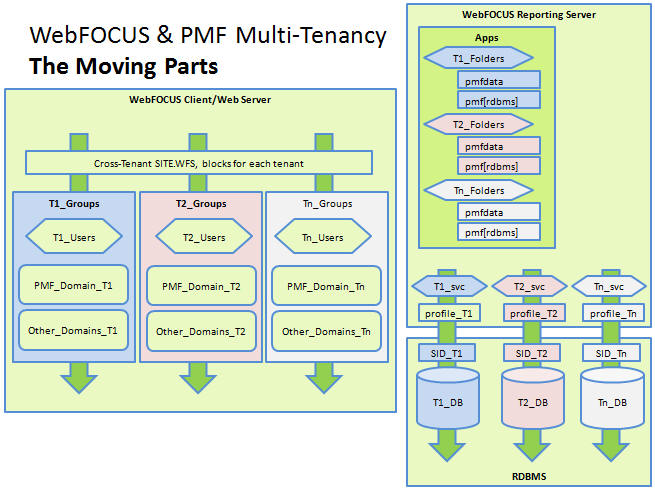There are two main variants of multi-tenancy and each depends on the nature of the types of customizations that tenants might require. The following image shows the parts that make up a multi-tenancy configuration.

The example scenarios used below assume that tenants want totally separate PMF data marts, MR domains, and Group Views. For more information, see Understanding Multi-Tenancy.
- The “Different Organization” Scenario. You might want to vary the PMF data marts for each tenant, have the ability to vary MR Domains while making them private to each tenant, and have Group Views for each tenant. This is typically the case if tenants were employed by different organizations, and there was a requirement that no tenant would ever be granted the ability to see each others MR or Group View content. This scenario would be followed if, for example, you were configuring PMF to support multiple groups of users in a SaaS environment where they remotely log in to the app and additionally need an absolute guarantee that they would never see the content of others. This type of scenario is the default assumption for multi-tenancy use. For steps on how to execute this configuration, see Installing PMF for Multi-Tenancy.
- The “Same Organization” Scenario. You might want the exact same MR Domain content and PMF Group Views for all tenants. It is fairly typical that the MR channels (Domain content) in PMF would be the same in the PMF Domain for all tenants. Tenants might not be concerned if they have the ability to share (when granted access) to other tenants MR and portal content. Typically, this would be the case if all tenants were groups employed by the same organization. If you need the ability to be able to share MR domain content among the various data mart users, you would use this scenario.
Before starting:
- It is assumed that you are using the same version of PMF for all tenants.
- You will need to agree on, and establish, a tenant name for each tenant data mart.